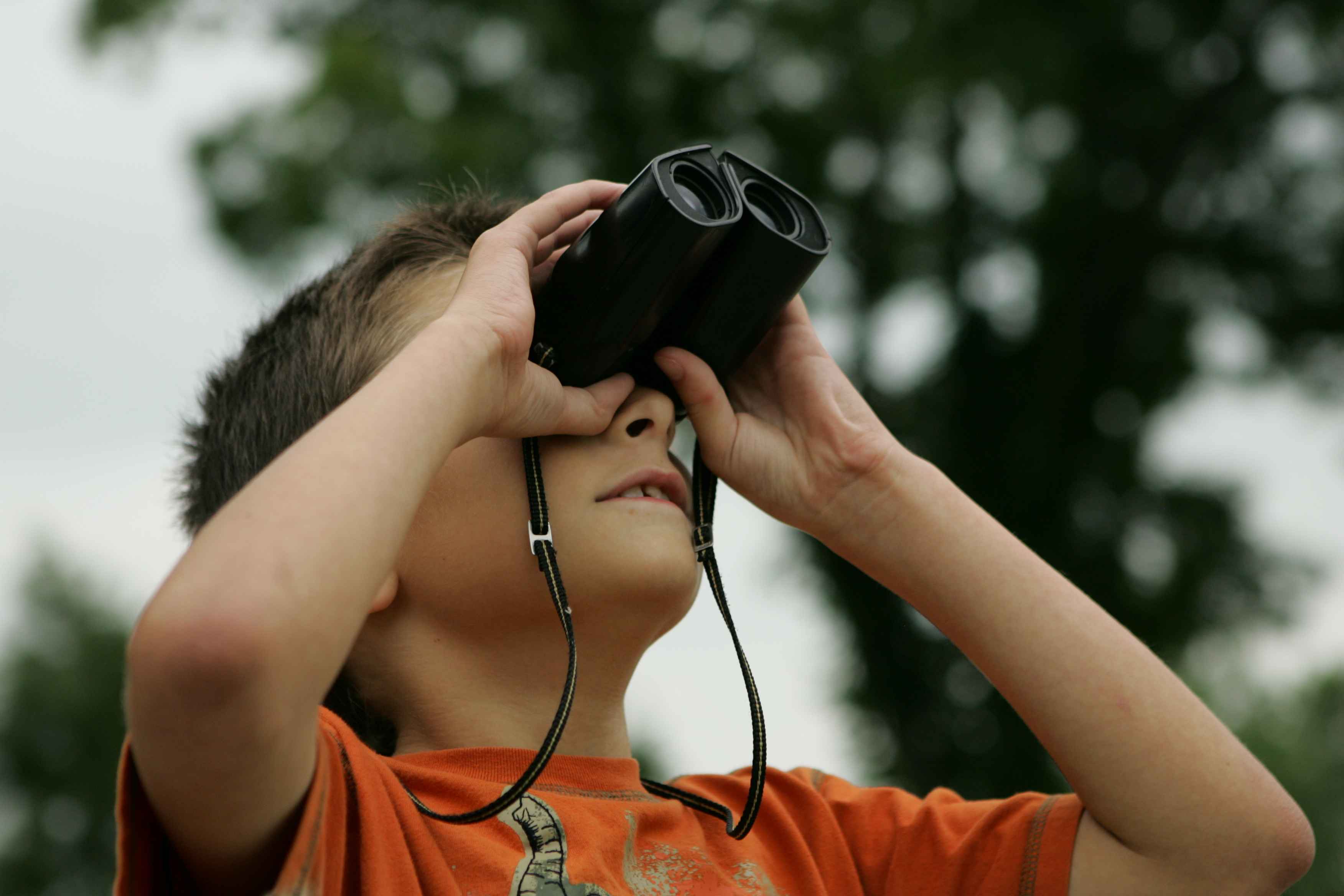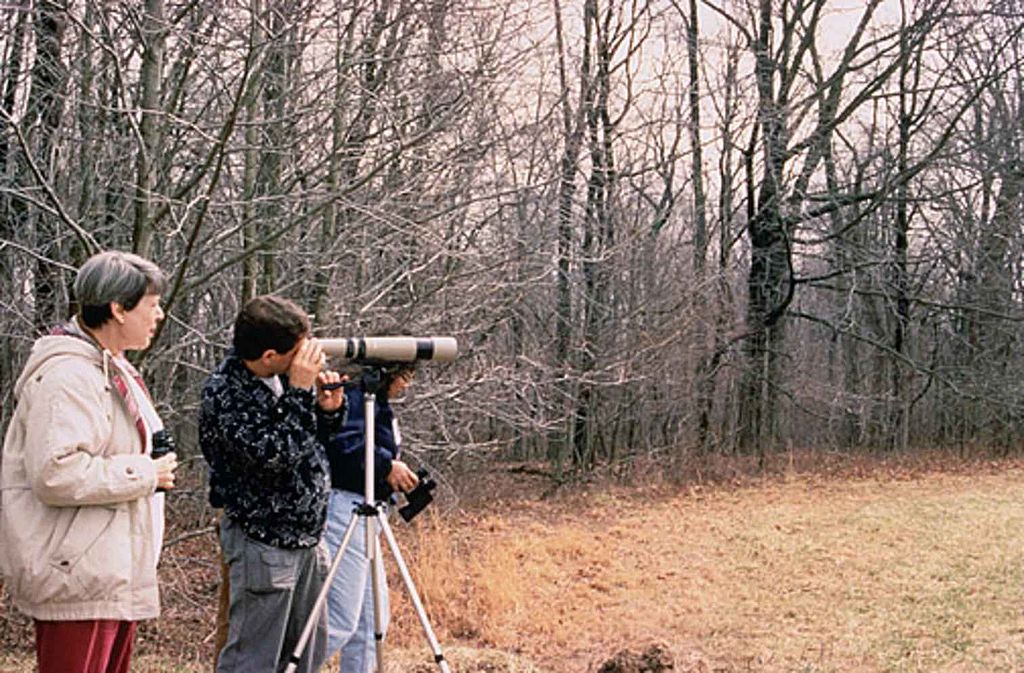 There are many ways to watch birds from the safety of your own home. However, there’s nothing like equipment that lets you get out into the field and look at birds head on.
There are many ways to watch birds from the safety of your own home. However, there’s nothing like equipment that lets you get out into the field and look at birds head on.
Things to consider before buying optics
Compare several makes and models. See what feels good in your hands and what fits your face. Examine the instrument you buy; don’t just rely on a company or a brand. There is variation in the quality, mechanical performance, and optical precision of all optics.If you buy mediocre optics, you will only replace them later with the ones you really wanted.
 What do the numbers mean? Binoculars come with numbers like 7×50, 8×29, 8×40 or 10×50. The first number is the magnification; what you see is that many times larger than you would see with naked eyes. The second number is the diameter of the large front (objective) lens in millimeters. The greater the number the more light is captured. So higher numbers such as 10×50 mean high magnification and a lot of light let in. Are they best for bird watching, then? Not necessarily, because 1) they are heavier than binoculars with smaller numbers and 2) they magnify movement as well. So they are best used in a stable situation when, for example, you are sitting or have them on a tripod. On the other hand 8×20 binoculars are light and easy to carry but have a smaller field of view and let in the least light. Good for backpacking but not serious birdwatching. Best for birdwatching are 7×35 or 8×40. Price? You can get very decent binoculars for less than $100. Again, try before buying.
What do the numbers mean? Binoculars come with numbers like 7×50, 8×29, 8×40 or 10×50. The first number is the magnification; what you see is that many times larger than you would see with naked eyes. The second number is the diameter of the large front (objective) lens in millimeters. The greater the number the more light is captured. So higher numbers such as 10×50 mean high magnification and a lot of light let in. Are they best for bird watching, then? Not necessarily, because 1) they are heavier than binoculars with smaller numbers and 2) they magnify movement as well. So they are best used in a stable situation when, for example, you are sitting or have them on a tripod. On the other hand 8×20 binoculars are light and easy to carry but have a smaller field of view and let in the least light. Good for backpacking but not serious birdwatching. Best for birdwatching are 7×35 or 8×40. Price? You can get very decent binoculars for less than $100. Again, try before buying.
Audubon Guide for Buying Binoculars
Birding Optics
Optics for the Tropics
Birder’s Exchange
Binoculars for Birds
14 Best Binoculars of 2021
Six Steps to Buying a Pair of Binoculars You Will Love
Binoculars Review
Best Bird Watching Binocular Review
Optics4Birding: User Reviews
How to Use a Spotting Scope and a Monocular for Birdwatching

Ask anyone who has attempted to zoom in and focus on a rare bird using a smartphone, and they will say the image always jumps and blurs. Beautiful birds in the wild deserve a good closeup look in order to appreciate it and confirm the identification. Sometimes binoculars, and other optical gear with zoom function, just can’t do the job of getting an avid birdwatcher close enough.
This is when you need a dedicated spotting scope. This piece of essential birdwatching equipment packs incredible magnification capabilities in a lightweight, simple package. Read on to find out how to spot a bird using a spotting scope or its optical counterpart, the monocular.
What Are the Disadvantages to Using Binoculars for Birdwatching?
Because binoculars with higher magnification have a smaller field of view, the bird image is not seen as brightly because there is less light. You have to hold binoculars more steadily – similarly to when using a smartphone zoom – the higher magnification will exaggerate any shaking, especially as binoculars are handheld.
Although it is possible to use a binocular tripod adapter to assist you in eliminating the shaking and blurring, it is a heavy piece of equipment to be hauling around with you in a good birdwatching country. Additionally, binoculars make it more difficult to focus on wildlife, especially when you are fortunate enough to have them come up close.
If you plan on using binoculars to watch birds in the distance, they are perfectly adequate for that. But if it doesn’t sound good enough for you, then you should only be considering a spotting scope or monocular setup. Be sure to read guides on how to conduct bird watching practices.

Getting Closer
Call it a pastime, hobby, or sport: the US Fish & Wildlife Service ranks birdwatching as the 15th most popular recreational activity to do outdoors, with over 47 million enthusiasts belonging to clubs and groups all across the States. This is why the spotting scope and monocular sales are rising at a high rate. This is good news for birders, as it means the technology and price range is continuing to develop alongside increased sales.
Any birder serious about getting closer to anything avian will prefer to hit the outdoors with a spotting scope. The scope might look like a telescope at first glance, but it is actually related more closely to the monocular. This is because both pieces of the kit feature an image-erecting prism system.
It also delivers wider magnification capabilities to birdwatchers, making it ideal for up-close images and birds flying far away in the distance. Many of the spotting scope eyepieces produce magnification power of 60x or more. While telescopes are more associated with celestial-based observations, the spotting scope is very much earth-orientated.
The optics, coatings, and housing design of a spotting scope is focused on optimal coloration and clarity.

A good spotting scope is sure to change your view of birdwatching completely. It is the fastest way to advance your checklist, and also better for detailed observations. It’s these kinds of details that are key to the spotting scope’s success in birdwatching circles. Reports of being able to read the bands on distant coastal birds means scopes are seen as vital pieces of kit for professional and amateur birders alike.
What Support Does a Spotter Scope Need?
With its super magnification capabilities, handholding a spotting scope is right out of the question. When you need to take a scope into the field, you will have to consider how you transport your birdwatching kit in total. This includes fitting your scope and tripod into a pack and walking with it from your vehicle to where you setup.
This is the big difference between using a monocular and a spotting scope for birdwatching. A monocular can be lifted up and used for a quick observation, whereas you need to set up a spotting scope and tripod for optimal observations.
Fortunately, spotting scopes aren’t heavy and therefore don’t require large tripods. Also, if you buy a tripod with telescopic legs you will be able to shorten it to fit into even the smallest pack. As the tripod is lightweight, it won’t need a heavier tripod head or alternative support. This is enough to provide your spotting scope with enough stability and mobility. In fact, the most popular advice given to birdwatching beginners is for them to get a good tripod.

Image used courtesy RHardy: Barred Owl, Rocky Point, Metchosin, BC.
Straight vs. Angled Spotting Scopes
Spotting scopes are available in two main general configurations: Angled viewing and straight viewing. The difference between the two is found at the rear of the scope. This is where the image-erecting prism directs the path of the light in a straight line to the body or at an angle (most typically 45° to the body). This straight/angled configuration in the first evaluation to be considered before buying a spotting scope.
For the record, beginner birders find it easier to operate a straight angle scope. It makes it easier for them to acquire a bird in sight and track it using the spotting scope. However, the angled spotting scope offers better viewing ergonomic comfort.

Image used courtesy Procular
Eyepieces and Objectives
The differences between eyepiece magnification and objective diameters is what separates spotting scopes from one another. The ones with fixed eyepieces are similar to the function of binoculars in that they carry both objective diameter and magnification in the product name description. Spotting scopes that have interchangeable eyepieces will only list the objective size.
The larger the objective listed on the product, the more light-gathering capabilities the scope has. The downside to this beneficial technology is that the weight and price are more.
Monoculars and Birdwatching
A growing number of birders are choosing to buy a monocular to supplement their birdwatching kit. It is a very popular birdwatching optic as the monocular is both mobile and compact.

And those are the operative words when it comes to buying a monocular for birdwatching, it must be small and lightweight enough to differentiate it from a spotting scope, but also compact enough to wear all-day around the neck.
If you buy a heavy monocular model for carrying around on a neck cord, you are better off just sticking with a monocular with a tripod or a spotting scope. You will really feel the strain after a few hours of walking outdoors with a large piece of kit pulling your neck down. The ultimate birdwatching kit will have a monocular for easy accessibility and quickly scanning the landscape without having to set up. And the spotting scope is for when you have found the ideal location and wish to put down roots for the day.
A monocular can hang around your neck the same as a pair of binoculars, except they are half the size and weight. As any keen birdwatcher will know, when you have only a few seconds to identify a bird in the wild for cataloging and adding to a checklist, fast access can make all the difference.
Spending the day with a lightweight monocular around your neck is no problem. If you pay attention to the specs on the monocular model you buy, you can avoid the bulkier options in favor for one that provides you with high-grade optics and great color definition, without a hefty price tag or weight.
Now that you have more information about how to use a spotting scope and monocular for birdwatching, you can start crossing off those entries on your birdwatching checklist for 2020!

Thank you for the tips when buying a binocular.
Pingback: Birds, Binoculars and Field Guides – Ornithology
First of all, Thanks for such a great article about Best Binoculars available on Today’s Market. Your article helped me to pick the right one,
Thanks for the article on binoculars and scopes.
Thanks for such a great article. This article is very helpful and essential for me.
This is an outstanding article. This article is truly helpful for us. Because this article’s guidelines help us to select the best Binoculars for our kids. However, thanks for share this beneficial article.
Thanks for your tips on the birding binoculars and spotting scopes! Help a lot.
Pingback: Binoculars Redux – Ornithology - Specialpets